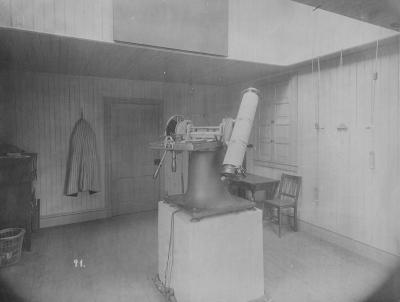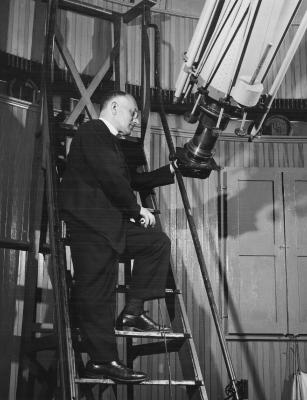The Georgetown Observatory was built in 1844, making it the fifth oldest building on campus and the third oldest college observatory in the United States (after Williams College and Western Reserve). Brother Joseph West, S.J., donated the land on which it is built to the University when he took his final vows. The building comprises 5,066 square feet and was built under the direction of Father James Curley, S.J.
Funding and Instruments
Father Curley recorded the cost as $7,910.59, but this is believed to be for the structure only, not including any scientific instruments. Two other Jesuits donated funds to the Observatory: Father Thomas Meredith Jenkins, a native of Baltimore, and Father Charles Stonestreet (University president from 1851-52).
As there were no American manufacturers of astronomical equipment at the time, instruments had to be bought in Europe. The first piece was an azimuth instrument, which is used to calculate deviation from north-south, purchased in Germany for $1,000 (that instrument was donated to the Smithsonian in 1971)1. Later, the University bought a transit instrument for calculating the movement of celestial objects from Ertl & Sons (also in Germany) as well as a five-inch telescope from Troughton and Sime in London. The University also bought two astronomical clocks (in 1841 and 1843) from Molyneaux in London, both of which still function. In 1891, a twelve-inch telescope was installed in the main dome and remains there. A darkroom and spectrograph were added in 1945.
Fr. Curley
Father Curley, who initiated the building's construction, taught physics, botany, chemistry, and astronomy. He is notable for being the first person to calculate the latitude and longitude of Washington without the use of advanced scientific instruments. Later, the Coast and Geodetic Survey placed a stone on the Observatory grounds marking where the observations were made. Curley also published the Annals of Georgetown Observatory in 1852, which was considered one of the best books on astronomy at the time. Father Angelo Secchi, considered to be the father of modern astronomy, said that Curley had been his inspiration.2
Curley also experimented with long-distance communication equipment. He constructed two speaking trumpets and placed one in the observatory and the other in the Quadrangle, allowing instant communication between the two.3
Late 1800s
In 1888, Father John George Hagen, S.J., came to Georgetown from Germany to become Director of the Observatory. He hired several staff members who became famous in the field of astronomy, including the inventor of the barocyclometer, Father Joseph Algue, S.J. The barocyclometer allows one to measure the proximity, location, and path of a typhoon from either sea or land.4
In November 1891, Father Hagen discovered a number of variable stars in the constellations of the Whale, the Twins, and the Little Dog.5
On September 29, 1896, the Cedar Keys Hurricane, the costliest hurricane to hit the United States up to that time, struck campus and caused minor damage to the building. A large oak tree narrowly missed falling on the telescope.6
Graduate Astronomy Program
In 1946, Father Joseph Heyden, S.J., founded the graduate program in astronomy at Georgetown. In 1948, he prevented the construction of McDonough Gymnasium from encroaching on the grounds of the observatory by standing in front of the construction equipment to block its path.
One of the graduates of the astronomy program was Dr. John Peter Hagan, who directed Project Vanguard, launching the second American satellite into space on March 17, 1959.
National Monument
In 1969, an act of Congress designated the observatory as a national monument. In 1971, as a result of increased light pollution and the prohibitively high cost of relocating it, the observatory was closed. It was renamed the Francis J. Heyden Observatory and Gardens in 1987.7
- 1"Ertel & Sohn Universal Instrument", Smithsonian National Museum of American History, https://americanhistory.si.edu/collections/search/object/nmah_758733
- 2Francis X. Ballman, "Observatory," Building Outlines Campus Buildings, 1789 – 1995, Father Lawrence Hurley Memorial Edition, Francis X. Ballmann and the Division of Facilities, 1995, pp. 76 - 82. NB Ballman writes that "Annals of Georgetown Observatory" was published in 1842, but the correct date is 1852.
- 3"Scientific Notes," Georgetown College Journal, May 1888, Vol. 15 No. 8, p. 95. http://hdl.handle.net/10822/1044410
- 4Francis X. Ballman, "Observatory," Building Outlines Campus Buildings, 1789 – 1995, Father Lawrence Hurley Memorial Edition, Francis X. Ballmann and the Division of Facilities, 1995, pp. 76 - 82.
- 5"University Notes," Georgetown College Journal, December 1891, p. 61. http://hdl.handle.net/10822/1044445
- 6"Notes on the Storm," Georgetown College Journal, October 1896, p. 5. http://hdl.handle.net/10822/1044493
- 7Francis X. Ballman, "Observatory," Building Outlines Campus Buildings, 1789 – 1995, Father Lawrence Hurley Memorial Edition, Francis X. Ballmann and the Division of Facilities, 1995, pp. 76 - 82.




